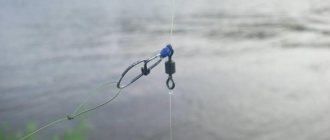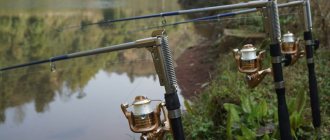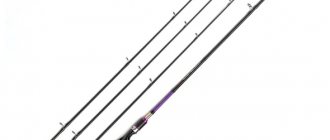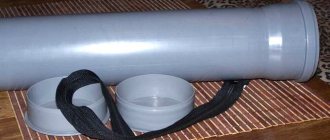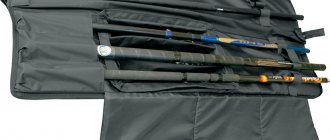Fans of winter fishing are very careful when choosing gear. Only an uninitiated person can believe that a winter fishing rod is a primitive design. This is, of course, not true. Just one whip for a winter fishing rod must meet many requirements.
In fact, the choice of all its components depends on many factors: the fishing location, the fishing method, the size of the expected trophies and even the strength of the current in the reservoir. The wrong selection of gear can leave a fisherman without catch at all, and, conversely, the right choice of equipment can significantly help during any fishing, even not very catchy ones.
An important element of winter fishing rod equipment is the whip.
Why is it needed and what is required of it?
Theoretically, a line with, say, a jig or bait can be immediately lowered from a reel or reel into the water and thus fished. But, of course, such fishing is inconvenient, and it is unlikely to be productive. The fishing line, coming out of the reel, must be passed through the whip and the fishing rod in order to ensure the following qualities for the gear:
- strength when biting and playing fish of any weight;
- the whip should be moderately flexible, this will prevent the line from breaking;
- flexibility also allows you to play with a jig or spinner;
- when fishing with a balancer, it also functions as a nod, signaling a bite.
Whips come in different lengths and strengths depending on the fishing method.
Sometimes whips are also called fishing rods, but this is not entirely true. Most fishermen share this gear. The fishing rod is equipped with guide rings and is located at the base of the fishing rod. While an ordinary whip contains almost no additional fittings, with the exception of a structure for attaching a nod or a tulip.
Customer reviews.
- They walked for a long time. They arrived whole, which was surprising when I looked at how they were packaged. There are five pieces in the set. The whips are full-bodied. Suitable for a winter fishing rod and as a vaccination for the first knee of a flywheel or lap dog. The most important thing is the diameter of the whips: in its thin part it is 0.8 mm, in the butt it is 1.7...1.8 mm...
- The whips are good, they arrived very quickly, it took about a week. Five pieces, as stated, are completely solid, not made of fiberglass, not a tube. They bend well from the butt to the top and made a loop. Thanks to the seller! I recommend him!
- Good whips, but the whips are of different thickness and stiffness. I liked the quality, despite the soft packaging they arrived intact.
- Everything has arrived. The seller was in touch. I ordered 5, but 6 arrived, one is broken by 3 centimeters, packed in bubble wrap, the tops seem normal, but they seem very thin to me, in general I’m happy, otherwise I couldn’t find 45 cm anywhere in Moscow.
- Good whips, but keep in mind that they are only for perch.
- I bought it for a homemade rewinder, it bends perfectly and at the same time is rigid.
- A good product. Thin but very durable. It serves its function.
Materials for whips
Traditionally, winter fishing rod whips were made from bamboo or juniper . Such tackle was convenient, sensitive, but did not have a margin of safety and quickly broke. Over time, the industry began to use other material options for this equipment, and each type of similar model had its own advantages and disadvantages.
Titanium
This type of whip is characterized by increased strength . It is used when catching large fish when it is necessary to withstand heavy loads. Titanium tackle is often used in strong currents. Such whips are especially good when fishing for moving predators - large pike or pike perch - using a balance beam or spoon.
The disadvantages of such equipment include the fragility of the structure .
Polycarbonate
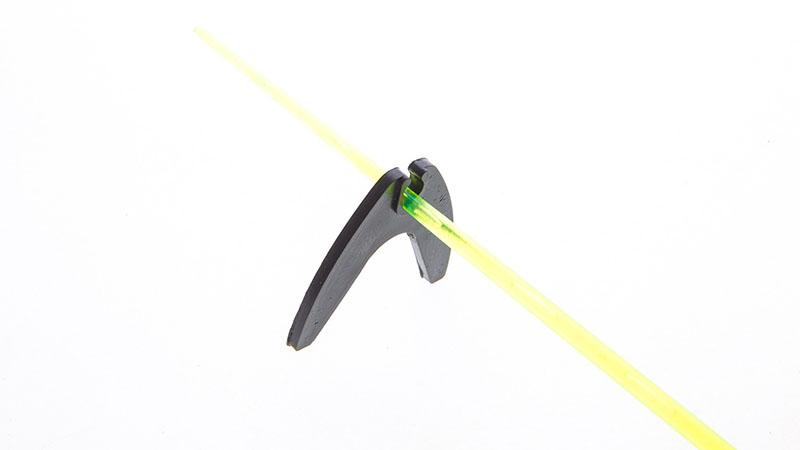
This material for making whips has fairly high strength and flexibility. Many fishermen note its good frost resistance . Intended mainly for catching medium-sized fish using a standard jig.
Due to the fact that these whips are relatively short, they are difficult to use when trolling or fishing, say, for devils.
Fiberglass

A very flexible type of whip that allows active fishing not only with a jig or bait, but also with small spoons. However, when fishing with heavy baits, large spoons, balancers, and in general when catching large trophies, such tackle is not suitable.
However, in industrial production there are now fiberglass products of increased strength due to increased diameter or combination with other materials. True, such tackle loses sensitivity.
Carbon fiber
These whips are usually hollow; the fishing line runs inside them. You can fish with them without nodding, as they are very sensitive. At the same time, a cambric is put on the end of the whip to protect the fishing line from freezing and sawing through the gear.
comparison table
Now let's summarize the information obtained in the form of a table.
| Type of gear | Advantages | Flaws |
| Titanium | Strength, lightness | Certain vulnerability of the structure if handled carelessly |
| Polycarbonate | Durability, sensitivity | Impossibility of fishing with devil and other similar baits due to the short design |
| Made from fiberglass | Flexibility and sensitivity | Difficulty working at great depths and with large lures |
| Carbon fiber | Sensitivity, good bait action | Weak strength |
“Blank” made of foam for a winter fishing rod
The search for a truly high-quality, reliable winter balalaika fishing rod made of foam often ends in nothing. The range of factory winter gear is represented by a huge number of a wide variety of winter fishing rods. At the same time, the lion's share is plastic of various colors, properties and quality.

The most common fishing rods in stores are balalaika and plastic.
At the same time, the original foam fishing rod has a number of advantages . One of them is minimal weight with excellent ergonomics. An almost weightless fishing rod, compactly hidden in the palm of your hand, is a very sensitive tool, which is confirmed by the practice and experience of experienced fishermen. As the weight of the fishing rod decreases, a heavier jig is required.
It should be noted that polystyrene foam is a “warm” material.
Tip: if you want to extend the life of your fishing rod, paint it with bright fishing varnish. At the same time, your gear will become aesthetically pleasing and will be more visible in the snow.
Usually, store-bought foam balalaikas, at best, can be used as blanks. Most often you can find a foam “stump” slightly turned at the edges with an insertable whip and a small reel for fishing line relative to the overall size. The quality of the whip almost always leaves much to be desired. The main disadvantage of a factory reel is difficult rotation. This structural element will have to be worked on.
One good thing about the factory gear is that I paid a penny and received a blank for a future trouble-free winter fishing rod.
So, let's consider the strategy for making a fishing rod from foam:
1. All excess foam is cut off from the body.
2. The workpiece is turned and polished. In this case, the work is carried out, as they say, from scratch, focusing on your preferences.
Important points:
- decorative delights are an unnecessary luxury that weighs down the tackle;
- preferable is a thin, uniform “shell” of foam around the reel for fishing line and a small “spout” with a pair of holes: for attaching the whip and bringing the fishing line out;
- painting the gear in bright, contrasting colors on the snow;
- Marking the line diameter with a marker.
For lovers of winter fishing, a note: How to install girders.
Store models of whips
| Name | Peculiarities | Price |
| DELFIN SORSA | With a metallic nod. Suitable for catching pike or zander | 120 rub. |
| DELFIN KILPA | Hard whip with adjustable nod | 120 rub. |
| GRIFON | Durable sixes in different sizes | 20 rub |
| AKARA | Whip with a metal ring on the ring | 70 rub |
| AKARA equipped | Equipped with a silicone nod | 77 RUR |
| Six 120 mm | Mass domestic release | 5 rub |
| Six 220 mm | Plastic product for “balalaikas” | 8 rub |
As you can see, the choice of such products is quite wide, and you can even get by with quite budget models, which, of course, do not differ in high technical characteristics, but have the ability to be quickly replaced in case of breakdown or icing.
DIY whip
Despite the abundance of store-bought options, many anglers prefer to make their own whips. This is both interesting and allows you to make homemade tackle that will be convenient and suitable for catching a specific fish, if you know exactly who you are going to catch in a given place. Moreover, it is not at all necessary to use expensive materials.
Telescopic
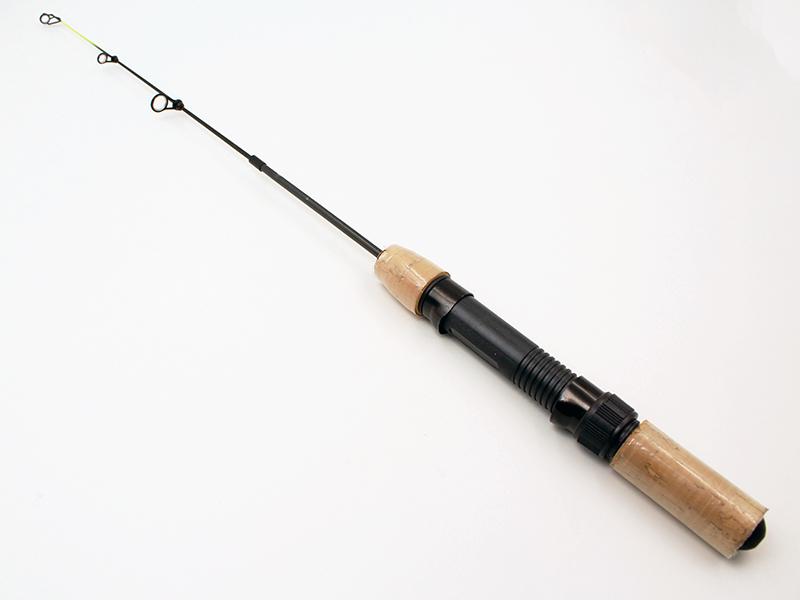
To make it, you can simply buy a tip for an ordinary telescopic fishing rod in a store. The process then looks like this:
- cut off the part from the tip that, according to the plan, will extend out of the fishing rod;
- use the sharp end of the cone to push it into the resulting hole;
- cut off the remaining blunt end of the tip to the required length;
- insert it into the handle, which can be made of foam plastic, by making a hole of the required diameter in it;
- equip the resulting whip with a ring at the very end and in the place that is formed when folding the telescopic structure.
This retractable tackle is well suited for trolling. Moreover, if you make the whip longer, you can fish while standing, hunting for large predatory fish.
Mechanical from a spring
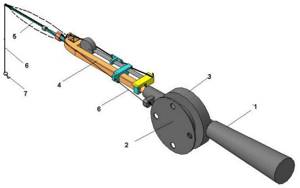
The spring itself is indicated here by the number 4. The rest is clear.
The main task of this mechanism is to imitate the vibrations of the nod, which a fisherman usually produces with his hand when fishing with a jig. The ability to make these vibrations, which are transmitted to the jig, does not come immediately, and changing the amplitude of movements is often too tiring. In this design, the fishing line passing through a special slider is swung by a kind of pendulum from a clock spring located at the base of the whip. The manufacturing process is as follows:
- the base of the whip is made, you can take wood for this, some use a more elastic material, for example, dense rubber;
- a spring with a slider and a counterweight is tightly fixed at the base;
- a nod is attached to the outside of the whip.
The line is passed through the slider and brought out to the nod. With a slight shaking, the spring with a counterweight and a slider will rhythmically swing the fishing line, and the fishing line will communicate the movement to the nod. Using the slider you can adjust the amplitude of vibrations.
Mechanical whip for winter fishing rod. Scheme. Video
I thought for a long time where to start this article. The question concerns a new approach to mastering the game with a jig (the foundation for training a mothless fisherman) with the help of new partially mechanized gear. But mechanization often causes negativity among experienced and active fishermen. Sometimes it is rejected outright, without any study of the equipment, various epithets are used such as that mechanics are for quitters and slackers, etc. and so on. It wouldn’t be such a big deal if it didn’t affect beginners or those fishermen who can’t master the game, so they are afraid to speak up and give up trying to master the game.
The “authoritative” opinion acts in such a way that even trying a new tackle seems shameful. Conservatism is useful if it is based on the search for real shortcomings, but this is a different case. As for the idlers, this is still a big question, because when fishing, the most labor-intensive job is making holes, previously they were hollowed out with picks, even if the “non-idlers” refused to drill.
My opinion and approach are not a panacea, I may be wrong in some ways, but these are my observations, my experience. The main thing is to look for ways, try, analyze.
First of all, I appeal to the fishermen who are not successful in the game, I want to assure them that the opinion that they are incompetent, that they are not on the water much, is not based on the real state of affairs. Only successful jig makers talk about this. Ask them in detail about the technology for mastering the game, the more detailed you are, the more clearly you will see that they themselves do not know why the game works for them. Practice is practice, but there is more to it. Of the fishermen I know, “good jigs” are no exception, but their difference from me is that they all have good, even handwriting, and the best of them simply has calligraphic handwriting. Perhaps this is not the only thing that is the basis for success in mastering the game. It so happened that I began to master the jig together with a friend who has an even, neat handwriting, we went fishing together, after several fishing trips he began to catch the game tolerably and his results grew, and my attempts to master the game using the traditional method were not crowned with success in four season. Trying to copy someone else’s experience didn’t help either; it’s stupid to copy someone else’s handwriting. Actually, my friend’s successes pushed me to study the issue and look for ways for people like me.
What is the traditional method? First, there is no stage of placing the hand, although such a concept exists in many professions, where the hand is the basis of the matter. Musicians—for them, hand placement is an axiom. With my unfortunate handwriting, I was a first-class radio operator in the army, why, because mastering Morse code begins with simple hand positioning exercises, they consist of training the skill of making uniform oscillations with the forearm at low speed. It’s clear that playing with a jig is a hobby, a recreation, and not a profession, so no one really bothered about preparing a jig. These thoughts came to me when I created a whip with a pendulum, which, as is known, has a stable oscillation frequency. It reminded me of a metronome for training musicians, and I also remembered learning Morse code. It turns out that the bicycle was invented a long time ago, why not use it? Moreover, I think it would be a sin not to use it, otherwise we will simply be ignorant.

As a result, I came to the conclusion that anyone can master the jig game relatively quickly if they first put their hand on it. The simplest simulator is a weight on a spring plate, previously bent upward so that the plate takes a horizontal position under the load. Now we swing the weight, the hand is forced to swing synchronously with the weight, otherwise it will not make complete (harmonic) oscillations. The pendulum swings with a stable frequency, and with it the hand. By changing the length of the plate, we change the frequency.
The mechanical whip is based on this simplest simulator, the output frequency of which doubles.
After all, fishing is a vacation and not everyone has the time and desire for special training with a simulator, and in this case, a simulator is gear. You catch fish and train your arm. If you want to switch to fishing with a regular whip, then this tackle is a simulator, if not, then it’s just a tackle that is easier to catch with a game than with a regular whip. New tackle with a wider range of frequencies, amplitudes, rhythms, types of vibrations (hard, soft, smooth). The opportunity to catch appears from the moment the hand can move synchronously with the weight, this takes from several seconds to several minutes. By the way, using the gear trains the hand to make uniform oscillations, regardless of the desire of the fisherman.
However, my tackle only helps in controlling the game of the jig, but we must not forget that the game depends on the jig itself, the nod, the fishing line and a number of factors. Fishing with a jig is not only the right game, but also correctly selected, balanced tackle, finding a place and much more that you need to know and be able to do, which comes with practice.

Now briefly about the mechanical whip and its properties:
- simplicity of design, max. weight 20 g and max. length 16 cm;
- manual control of the fishing rod and jig, i.e. all the sensations of hand fishing;
- No skills in the technique of “playing” with a jig are required for use. Allows an inexperienced angler to immediately fish with a “game”, including a nozzle-less jig, while at the same time training (positioning) his hand for fishing with a regular whip (simulator);
- no need to learn traditional fishing techniques;
- the whip will allow an experienced fisherman to significantly expand the possibilities in the technique of playing with a jig, doubling the frequency of oscillations of the jig, without disturbing the comfort of the hand;
- the amplitude is adjusted by the bushing and during the game the fisherman is focused only on maintaining the desired frequency (note maintenance, not creation). The frequency is set by moving the slider;
- The frequency is smoothly adjustable from 150 to 750 vibrations of the whip per minute. You can apply graduations on the body to make it easier to set the “cool” frequency;
- switching to the use of a mechanical whip does not require changing fishing gear;
- interchangeable with a standard whip for medium-sized mass-produced fishing rods;
- The design allows the use of one whip for small and medium-sized jigs. It is enough to have a couple of whips (a second spare), installing alternately on a working fishing rod;
- guarantee of stable play, i.e. frequency and amplitude are stable at the same time;
- the mechanism has the ability to reduce the load on the arm muscles by up to 10 times, which allows you to play with a jig with high frequency for a long time without causing fatigue;
- allows you to play equally both when raising and lowering the jig, you can play in one place, on the bottom;
- the whip produces vibrations with a frequency twice that of the hand;
- The mechanism has some inertia, which guarantees that the jig will not oscillate.
For those who want to make their own whip, I provide drawings.
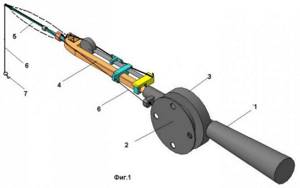
Figure 1 In figure 1, position 4, this is the mechanical whip, the rest does not require any special explanation.
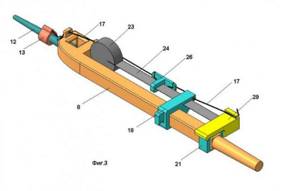
Fig.3 Whip. 8 – base; 12 – rod; 13 — rubber bushing; 17 – flexible connection (line 0.01); 18 — slider (sliding); 21 – support (rigidly installed); 23 — weight (lead ~10 g); 24 – elastic plate (thickness 0.1 mm); 26 – slider (sliding); 29 – retainer.
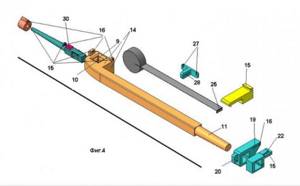
Fig.4 16,27 – guide holes (for flexible connection 17); 30 - shock absorber (foam rubber or soft porous rubber).
View from above.
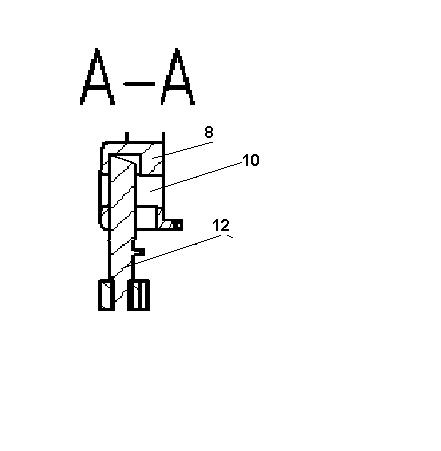
10 - rectangular hole; 12 – rod
The drawings are made for plastic casting. When done manually, the fastening of the rod at the base can be made hinged (install an axis), which slightly simplifies the fastening unit (A-A). Instead of a protrusion with a guide hole on the rod, you can put a rubber bushing with a hole on it, which allows you to make additional adjustments. The runner and slider should not move randomly during oscillations, but should be moved by hand with little effort.

For clarity when making a whip, I post a photo. Changes were made to the model as testing progressed, I decided to show some of the models, I think for the DIYer, the more information the better. On fragment 1.2 there is one of the first versions made of metal, then fragments 3-6 of the model are made of plastic, or rather from the profile of the cornice photo 7.
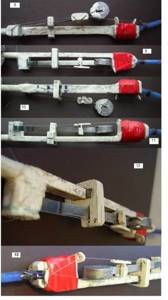
These were models for testing and sizing, one of which is now in use. Fragments 8-13 are the last option for practical use.
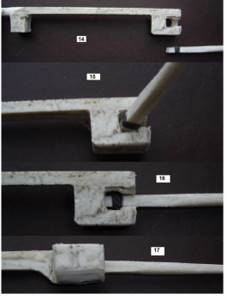
Fragments 14-17 installation of the top on the base. The base is poured (or rather compacted) from pieces of polypropylene (pipe) in an aluminum mold, when heated. When choosing plastic, you should consider how the material will behave in the cold; there are plastics that become brittle and break easily. I think you can use wood, for example birch. The photo clearly shows the passage of a flexible connection (line 0.1). It is not advisable to use a fishing line with a larger diameter, because it will not fully straighten under the load of its own weight of the tip-nod-jig and will have a negative impact on the game. In places where the fishing line slides, I glued beads in to reduce friction. The spring is made from a Soviet 10-meter tape measure, ground down in thickness from 0.2 to 0.1 mm, the width of the spring is 4 mm, the spring is pre-bent upward so that it assumes a horizontal position under the weight of the load.
The spring, the part that experiences the greatest loads, breaks periodically; you need to have spare springs. There are metals with hidden defects and cracks, which can break very quickly. Depending on the loads and in the absence of metal defects, the spring can last from several fishing trips to the entire season. Instead of a steel spring, you can try using a Mylar strip.
The load is lead 10-11 grams, if you use only light jigs the weight of the load is sufficient - 7-8 grams. However, a heavier load has greater inertia. If the whip is planned to be used only for high frequencies, then in this case the length of the whip can be reduced. The tip is inserted into the base socket without using an axle to reduce friction, because During oscillations, the tip falls under the slight own weight of itself, the nod and the jig. Foam rubber is placed in the socket above the tip - this eliminates knocking and slightly cushions the tip. The slider was cut out of plastic, before putting it on the base, a slot was made and heated in boiling water. The slits on the runner were made with a strip heated over the fire, a waste from the spring.
The runner and slider should not move spontaneously during operation; they should move with slight hand effort. Adjustment of the game is carried out by a slider, a bushing on the top, a slider and, of course, by changing the force of the hand when playing. You can do everything your own way, but you need to take into account that the line from the slider to the first hole on the protrusion of the base (the hole with the beads) should be as close as possible to a straight line and the slider should be on this line. Only in this case, each displacement of the load up or down and return to the horizontal gives one complete oscillation of the tip (jig).
If you want to make the arm, pendulum and jig oscillate synchronously, bend the spring down so that it and the load are at an angle of 30-40 degrees relative to the base. Of course, this is very brief, I hope I can give explanations as questions arise during the manufacturing process. I wish everyone good luck on the waters.
What is described in the article can be seen in the video:
Video lesson.
Real results of training during one season, according to the specified methodology.
I wish you all creative success. Baydatsky Valery.
How to attach to a fishing rod
In some designs, the whips are simply glued to the fishing rod or handle, this makes the structure durable and comfortable during fishing. But such a structure is not very suitable for transportation. “Balalaika” can still be transported in a small fishing box, but the structure for catching large predatory fish is difficult to carry in an unassembled form.
Therefore, many anglers prefer to use removable whips, which are attached to the fishing rod using metal or hard plastic tubes. Telescopic structures also help to get out of the situation.
Where and how to store
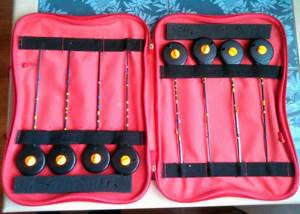
There are 3 types of very convenient storage of spare gear for winter fishing:
- Plastic cases. Convenient topics. that they do not deform during transportation and storage; such cases for whips have special fasteners.
- Organizers. They are distinguished by their versatility; there are compartments not only for whips, but also for jigs, hooks, spinners, etc.
- Covers. They can be sewn to your taste with special pockets and fasteners.
